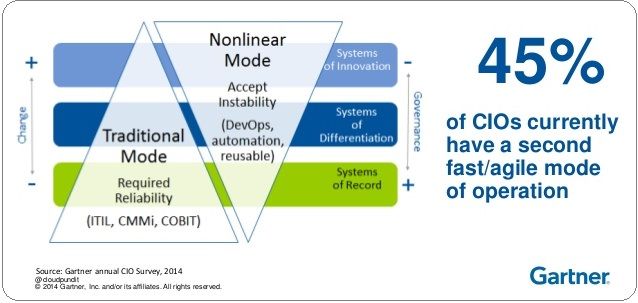Technology Driven Disruption
Technology-driven disruption is everywhere; it’s becoming a cliché. Entire industries are being flipped on their heads by nimble startups teeming with full-stack developers, who, with well-worn copies of The Lean Startup and the Manifesto for Agile Software Development in hand, use the latest software development tools and processes to crank out code with stunning speed. And, not only can they innovate quickly, their response is lightning quick when business needs change.
How important is speed when it comes to business and technology? According to Dave Girouard, former head of Google Enterprise Apps and now CEO of Upstart, speed is the ultimate weapon in business. “All else being equal, the fastest company in any market will win. Speed is a defining characteristic — if not the defining characteristic — of the leader in virtually every industry you look at,” he says.
Understandably, this makes leaders in large enterprises quite nervous. While eCommerce, social media, and other “silicon valley” type startups continuously raise the bar for speed, agility, and amazing customer experiences, their own corporate IT departments seem hopelessly bottlenecked as they struggle to simply maintain monolithic legacy systems, let alone adapt them to meet next-generation business realities.
The problem is that large enterprises are caught between the proverbial “rock and a hard place”. They need to adopt lightweight and rapid application development tools and processes to keep up, and at the same time they cannot afford to compromise on the robustness, security and scalability of their systems.
The Need for Bimodal IT (aka 2-Speed IT)
This conundrum is exactly why Gartner’s idea of “bimodal IT”, or “2-Speed IT“, has become so popular among CIOs. First described in 2014, Bimodal IT is:
“the practice of managing two separate, coherent modes of IT delivery, one focused on stability and the other on agility. Mode 1 is traditional and sequential, emphasizing safety and accuracy. Mode 2 is exploratory and nonlinear, emphasizing agility and speed.”
The consulting firm Mckinsey has also been pushing a two-speed architecture, which they say
“… implies a fast-speed, customer-centric front end running alongside a slow-speed, transaction-focused legacy back end. For software-release cycles and deployment mechanisms, the customer-facing part should be modular, to enable quick deployment of new software by avoiding time-consuming integration work. In contrast, the transactional core systems of record must be designed for stability and high-quality data management, which leads to longer release cycles.”
So, 2-speed IT (or Bimodal IT) is about reconciling the different technology goals between business units who want to focus on iterative innovation with rapid application evolution, and IT departments who are accountable for maintaining enterprise-class SLAs, and understandably want to focus on stability and reliability.
But how can large enterprises dependent on legacy systems start moving towards 2-speed IT? Does the already strapped IT department now need to spend cycles researching new tools, making dead sure they don’t introduce new technology risks to the organization?
Enter Oracle Application Express (APEX)
Well, for organizations using the Oracle database, the answer might just be a “hidden gem” called Oracle Application Express. With APEX, implementing 2-Speed, or Bimodal IT is a cinch. And the best part? APEX comes free with the Oracle database, so there are no extra costs to start using it.
APEX is a fully supported, rapid application development framework included with the Oracle database as a no-cost option. It’s specifically designed for quickly developing and deploying web and mobile applications, which are highly functional and provide a rich and unified user experience “right out of the box”. And, since it is built into a world-class, top-tier database platform, APEX enables enterprises to have the best of both worlds: fleet-footed software development capabilities combined with the uncompromising security, scalability, and robustness for which the Oracle brand is known and trusted.
Here’s an example of what I mean. Let’s say a company has a custom-built legacy financial system sitting on an Oracle database, with the core business logic in packages. (Or, it can even be Oracle E-Business Suite since APEX works great for developing EBS extensions.) Now, let’s say a business unit wants a mobile application that can access some of the data to provide a dashboard of sorts for field staff, and also wants the field staff to be able to update key pieces of information. And, of course, they need it yesterday.
Well, APEX would work perfectly. Using APEX, a developer could leverage the existing business logic by using the same database packages, and use the built-in functionality to quickly build a mobile application to expose the system’s functionality to staff in the field, all without having to set up a complex mobile application development framework, re-test the business logic, build APIs to access the packages, etc., etc. It’s quick, non-intrusive, and safe. Everyone’s happy: The business unit is happy because they now have their app. IT is happy because they’re able to stay within a trusted technology stack and not introduce any further complexity or risk, and the CEO is happy because he has a better chance of meeting business objectives and making his numbers.
Getting Results with APEX
At this point, you’re likely thinking I’ve “drank the Oracle Kool-Aid”, or perhaps am earning some sort of commission for selling APEX. Let me assure you that’s not the case. I certainly don’t love everything about Oracle, (don’t get me started on how a mere mortal is supposed to understand the licensing fees), but “love ‘em or hate ‘em”, the fact is I’ve seen first hand how companies have used APEX with amazing results in terms of ROI and time to market. And, since joining Insum, I’ve had the opportunity to chat with a few of the long-time APEX developers, and have heard story after story along the lines of how someone used APEX to implement something in days or hours where other teams had been working for weeks or months, using some big “enterprise approved” development framework or another, with no end in sight.
So, if you’ve not yet had the chance to explore what you can do with Oracle APEX, you owe it to yourself and your organization to see how you can use APEX to shift into a higher gear.
P.S. Another important aspect of bimodal IT is innovation, and specifically, systems related to innovation. Here again, APEX can help – I’ll cover that in a future post.

